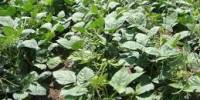Buttery corn on the cob is one of the most iconic summer foods in America, but as summer temperatures soar to previously unheard-of heights, the future of sweet corn may not be so rosy. Intensive heat during flowering dramatically reduces sweet corn yields, according to recent University of Illinois research, particularly in Midwest rainfed areas.
Climate projections don’t just predict a handful of hot days going forward. By the middle of the century, much of the United States is expected to experience 20 to 30 more days with temperatures above 32oC (approximately 90oF).
“The reality is that producing sweet corn, one of the most popular vegetable crops in the U.S., will be more difficult in the future. We need to develop new approaches and technologies to help crops adapt to climate change,” says Daljeet Dhaliwal, former graduate research assistant and lead author on the study published in Scientific Reports.
Dhaliwal studied the yield response of sweet corn to growing season temperature and precipitation during a 27-year period in collaboration with Marty Williams, a USDA-ARS ecologist and affiliate professor in the Department of Crop Sciences at Illinois.
Williams obtained private data from sweet corn processors for 16,040 individual fields in Illinois, Minnesota, Washington, and Wisconsin, providing a much finer resolution than similar studies in field corn using county-level data.
The thing we really need to do to prevent worse outcomes is to minimize further climate change. But we’re in a period where we’re going have to deal with what’s already set in motion. Our trajectory is already set for the next several decades.
Marty Williams
“Our analysis reveals that small temperature changes have a greater influence on crop yield compared to small precipitation changes for both rainfed and irrigated fields in the Midwest and Northwest, but rainfed production shows greater sensitivities,” Williams says.
Extreme temperatures during flowering, he continues, can affect various processes, including pollen viability, fertilization, kernel abortion, and others.
“If there’s a bad time for extreme heat, it’s during flowering. That’s especially true in a crop where ear quality is so important. With heat stress during flowering, you can have ears with fewer kernels or very misshapen kernels that look nothing like what the consumer is expecting,” Williams says.
The notion of “extreme degree days” was employed in this study to describe the cumulative impact of temperatures exceeding 30°C (86°F) on sweet corn output. Ordinarily, degree days are computed by averaging the high and low temperatures during a certain 24-hour period. To calculate extreme degree days, Dhaliwal summed degree days over 30°C.
Every day with a high temperature during flowering reduced the output by 2% in rainfed areas. For irrigated systems, yield loss was less severe; just 0.5% per degree day over 30°C.
But more than one day at 40oC (104oF) could drop yield by 20%. This result was based on season-long hourly temperature data, not degree days.
The trend indicates irrigation could lessen the consequences of excessive heat, but climate predictions also warn that water supplies could become scarce in the future. The authors point out that if climatic extremes continue to reduce sweet corn output and quality, planting schedules or production locations may need to be changed to stay out of the harshest temperatures.
Williams claims that breeders can only do so much to incorporate heat tolerance.
How can we breed sweet corn to increase its resistance to the environment’s increasing stresses? To what extent can you do that by managing the crop versus improving the crop itself? These are hard questions.
“The thing we really need to do to prevent worse outcomes is to minimize further climate change. But we’re in a period where we’re going have to deal with what’s already set in motion,” Williams says. “Our trajectory is already set for the next several decades.”
















